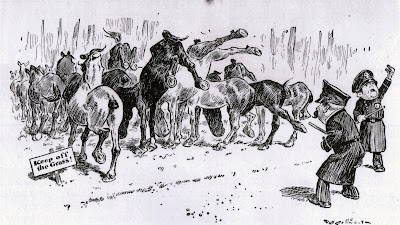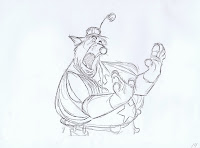I was thrilled when I got the assignment to supervise the animation of Jafar, the villain in the film Aladdin. I had just finished work on Gaston, who had to be handled with a certain amount of realism.
I remember thinking: Not with Jafar!
Here was a chance to design and animate a character who belonged in a graphically stylized world.
Animator Eric Goldberg had already done some incredible test animation of the Genie, which helped to set the style for character designs. Inspired by the fluid lines of famous caricaturist Al Hirschfeld combined with the voice of Robin Williams, Eric created a Genie for the ages and set the bar very high for the rest of us.
But how would I handle Jafar's personality against the uber entertaining Genie and the rest of the cast? Should I go along and give him plenty of lively gestures or should I downplay his acting and look for contrast instead?
I found out the more I held back and showed him thinking and plotting, the more evil and interesting he became. Sure there were scenes when eccentric acting was called for such as when Jafar turns into a beggar. The attitudes here show a hunger for power as well as extreme frustration.
All those scenes were animated beautifully by Kathy Zielinski.
Other animators in the Jafar unit were Nik Ranieri, Ken Duncan, Ron Husband and Lou Dellarosa.
Many different design ideas were floating around early on, before animation began.
A fun drawing by designer/story artist Daan Jippes.
This sketch by director John Musker showed just the right attitude to go along with Jonathan Freeman's voice recordings.
A couple of my early drawings with extra evil eyebrows. Didn't feel right though.
I order to loosen up I scribbled many facial expressions to explore the range of his facial features.
Setting Jafar's mouth very low on his face allowed me to create bizarre but interesting mouth shapes.
My attempt to tie down some of those rough faces.
How realistic or how cartoony should his hands look like? I knew I wanted hands you wouldn't want to touch.
Premature cleanup studies. The right type of personality is emerging, but his face has way too many angles and planes. Too complicated to look at and not in line with the style of the film.
Jean Gillmore drew these expressive poses.
I tried to minimize the line milage in the design. Still not stylized enough.
After one more pass I was comfortable with these animatable shapes.
This is the design directors Ron Clements and John Musker approved.
Clean up artist Kathy Baily creates the fine line look for the character.
An oversized drawing of Jafar with a cut out Iago provided by animator Will Finn.
I don't particularly enjoy drawing model sheets, it's all about measuring the components of the character and being consistent. They are important though because they explain the character "graphically" to your animation and clean up crew.
A cool design for Jafar's staff. We decided to close the snake's mouth though to save line mileage.
It probably saved the film's budget, too :)
A couple of my more or less typical roughs.
This is a clean up drawing from a scene that was cut from the movie
Jafar is muttering the magic word to make the gigantic tiger head appear in the desert.
That magic word was the name of our layout supervisor: Rasoul Azadani
Jonathan Freeman voiced the character perfectly, He loved being Jafar, and I loved animating to his inspired vocal performances.




























































































































































